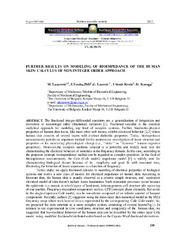Приказ основних података о документу
Further results on modeling of bioimpedance of the human skin: calculus of non-integer order approach
| dc.creator | Lazarević, Mihailo | |
| dc.creator | Vosika, Zoran | |
| dc.creator | Lazović, Goran | |
| dc.creator | Simić-Krstić, Jovana | |
| dc.creator | Koruga, Djuro | |
| dc.date.accessioned | 2023-02-26T18:30:06Z | |
| dc.date.available | 2023-02-26T18:30:06Z | |
| dc.date.issued | 2012 | |
| dc.identifier.isbn | 978-86-7746-344-1 | |
| dc.identifier.uri | https://machinery.mas.bg.ac.rs/handle/123456789/4658 | |
| dc.description.abstract | The fractional integro-differential operators are a generalization of integration and derivation to non-integer order (fractional) operators [1]. Fractional calculus is the essential analytical approach for modeling any kind of complex systems. Further, bioelectro-physical properties of human skin tissue, like most other soft tissues, exhibit electrical behavior [2,3] where human skin consists of several layers with distinct dielectric properties. Today, bioimpedance measurements provide an important method for the noninvasive investigation of tissue structure and properties or for monitoring physiological change (i.e., ‘‘static’’ or ‘‘dynamic’’ human organism properties). Moreover,the complex modulus concept is a powerful and widely used tool for characterizing the electrical behavior of materials in the frequency domain. In this case, according to the proposed concept, bioimpendance moduli can be regarded as complex quantities. In the field of bioimpedance measurements, the Cole (Cole model) impedance model [4] is widely used for characterizing biological tissues because of its simplicity and good fit with measured data, illustrating the behavior of tissue impedance as a function of frequency.In this study, we apply fractional calculus to modeling of electrical properties of biological systems and derive a new class of models for electrical impedance of human skin. According to literature data, the human skin is usually observed as a relative simple structure, and equivalent electrical model of skin doesn’t include tissue lamination. Such relaxation processes occur because the epidermis is a mosaic in which layers of laminated, inhomogeneous cell structure pile up on top of one another. Frequency-dependent components such as CPE (constant phase element), that exists in the single-dispersion Cole model, can be considered composed of an infinite number of lumped components. Recently, authors [5] suggested using the three-layer skin numerical model in the MHz frequency range where each layer of skin is represented by the corresponding Cole–Cole model. So, we proposed the skin structure as a more complex system, consisting of several layers(Fig.1). In relation to our experimental in vivo conditions, structure and complexity of the human skin, we suggested that bio-electrical behavior of the human skin can be described by the series layer Cole model using modified fractional distributed-order based on the Caputo-Weyl fractional derivatives. Our proposed model presents essentially modified single-dispersion Cole model, since it introduces a new parameters k and σ in single-dispersion Cole impedance equation. These parameters characterize the width of interval around fractional index α. Comparing our model to well-known Cole models, we conclude that these parameters are important for more accurate describing bioimpedance properties of human skin. Our modified Cole model much better fit to experimentally curve in given frequency range in compare to existing Cole models. The fitting is done using Levenberg-Marquardt nonlinear least squares. In that way, one may conclude that the electrical properties of skin can be modeled using a more discrete Cole impedance element rather than one discrete Cole impedance element.Last, some our results are related to generalized Cole element as well as constant phase element (CPE). These generalizations is described by the novel equation which presented parameter (β ) and corrected four essential parameters ( R0 , R oo, α , tau α ). Using serial combinations of the primary model elements we may obtain two new models and defined them by the appropriate equations and electrical schemes. | sr |
| dc.language.iso | en | sr |
| dc.publisher | Belgrade: Serbian Scientific Society | sr |
| dc.relation | info:eu-repo/grantAgreement/MESTD/Integrated and Interdisciplinary Research (IIR or III)/41006/RS// | sr |
| dc.rights | openAccess | sr |
| dc.rights.uri | https://creativecommons.org/licenses/by/4.0/ | |
| dc.source | Booklet of Abstracts of Symposium Nonlinear Dynamics –Milutin Milanković (Multidisciplinary and Interdisciplinary Applications), (SNDMIA 2012), Belgrade, October 1-5, 2012. | sr |
| dc.subject | human skin | sr |
| dc.subject | calculus of noninteger order (fractional calculus) | sr |
| dc.subject | frequency analysis | sr |
| dc.subject | bioimpedance | sr |
| dc.subject | Cole model | sr |
| dc.title | Further results on modeling of bioimpedance of the human skin: calculus of non-integer order approach | sr |
| dc.type | conferenceObject | sr |
| dc.rights.license | BY | sr |
| dc.citation.epage | 110 | |
| dc.citation.rank | M34 | |
| dc.citation.spage | 109 | |
| dc.description.other | http://www.mi.sanu.ac.rs/projects/booklet_of_abstracts.pdf | sr |
| dc.identifier.fulltext | http://machinery.mas.bg.ac.rs/bitstream/id/11198/LazarevicSNDMIA2012skin.pdf | |
| dc.identifier.rcub | https://hdl.handle.net/21.15107/rcub_machinery_4658 | |
| dc.type.version | publishedVersion | sr |


